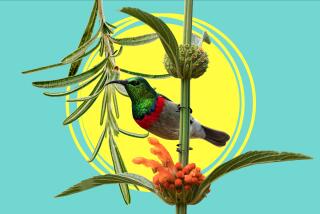For the Greenthumb-Challenged: Try the Umbrella Plant
- Share via
To anyone who has trouble growing houseplants, here’s one that is easy to grow: the umbrella plant.
The most common problems in growing houseplants arise from improper watering. Plants often die from too much water or too little water, or a combination of the two.
But the umbrella plant requires no skill at all in watering. The plant is native to shallow waters, so there’s no need for you to decide whether it is time to water. Water is always needed! The way to grow the umbrella plant is by standing its pot in a deep saucer, which you always keep filled with a couple of inches of water. What could be simpler?
The umbrella plant is not homely, sacrificing good looks for ease of care. The plant grows as a graceful clump of bare, slender stems, each capped by a whorl of leaves radiating out like the ribs of an umbrella. The stems are 2 to 4 feet tall, and each leaf 4 to 8 inches long. There is a dwarf form that grows only a foot or so high, with grassy leaves growing at its base, as well as a variegated form, and a wispy one with especially thin leaves and stems.
Umbrella plants are not finicky about care. They grow best in sunny windows but will get along in any bright room. As far as potting soil is concerned, your regular homemade or packaged mix will suffice. Repot the plant when stems crowd, either shifting the plant to a larger pot or dividing the large clumps into smaller clumps and potting each of them separately.
You may be unfamiliar with the umbrella plant, but you probably have come across its relatives either in the garden or in literature. One relative is yellow nut sedge, a plant usually considered a weed and inhabiting wet soils all the way from Maine down to the tropics. Before you condemn this plant, though, taste the small tubers attached to the roots. They are delicious, and one reason for another of the plant’s common names, earth almond. The plant is sometimes sold as chufa.
The umbrella plant’s other relative is papyrus. It once grew wild along the Nile river. In ancient times, papyrus was used not only to make paper, but also to build boats and as food.
Papyrus looks much like the umbrella plant, and being subtropical, also would make a good houseplant. But with stems that may soar to 15 feet in height, this species is too tall for most living rooms.






